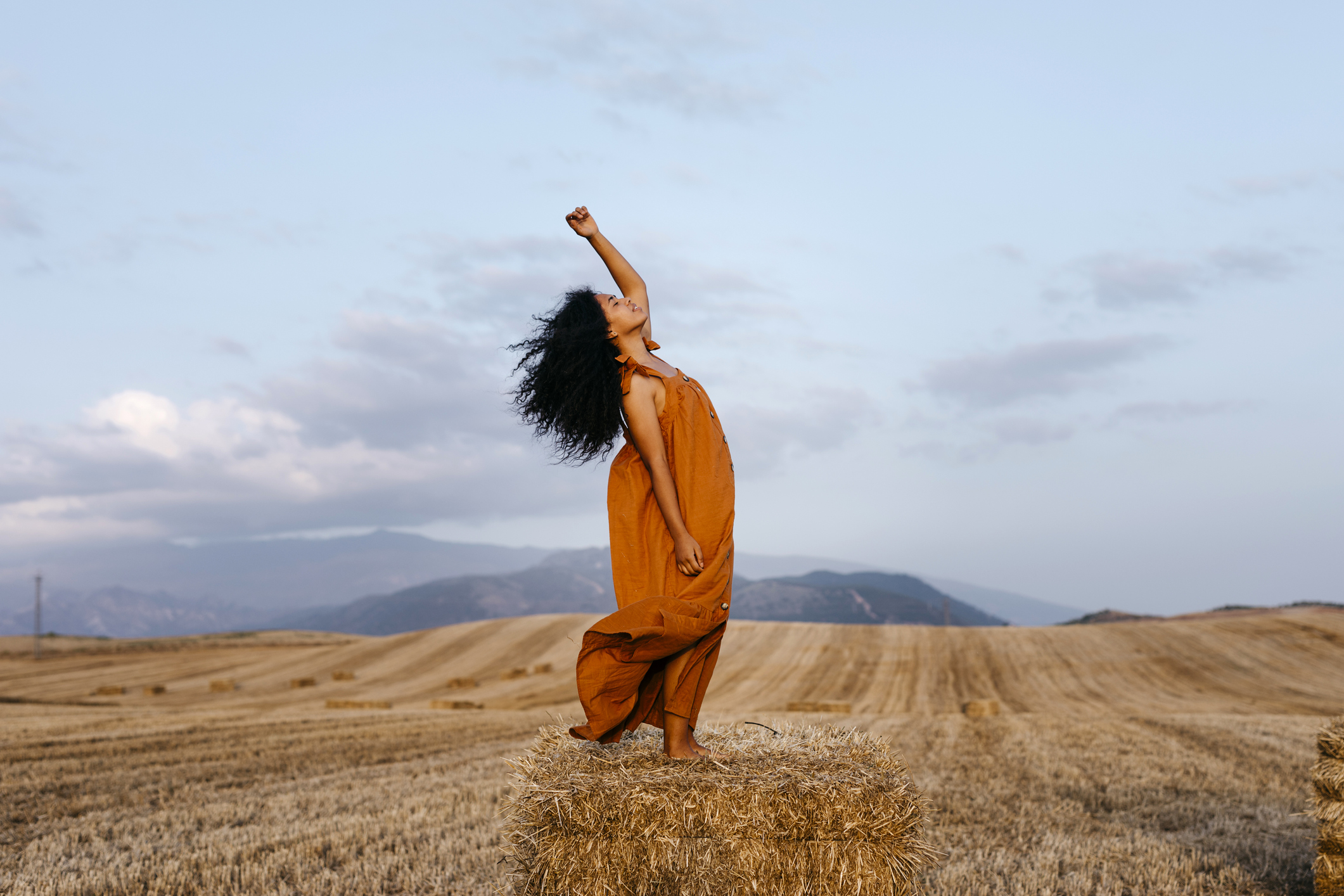Search for "dance for happiness" is rising - so can it really boost your endorphins?
Studies show that freeform dance has a whole host of benefits -here Emma Marshall, the Wim Hof of dance’ explains it could help you


Studies show that freeform dance has a whole host of benefits -here Emma Marshall, the Wim Hof of dance’ explains it could help you
Picture the scene: you're at a festival, surrounded by like-minded individuals, dancing to one of your favourite artists as they perform live. The term "dance for happiness" is rising in search on Google, fuelling the longstanding theory that freeform or flow dance is not only one of the best forms of exercise to tone up a body, but a great way to boost your mental health, too.
“Using dance with clear intention can help release trauma, regulate the nervous system, and help the person come back into their body,” says Emma Marshall, founder of Movement is Medicine, a class that combines the science of somatic therapy with the ancient teachings of ecstatic dance.
Marshall's practice came about after serious health problems in 2019 which left her unable to walk and with not enough energy to leave the house, so she heavily researched alternative practices like reiki healing and like EFT tapping and ancient theories regarding the connection between mental and physical health.
“I gave myself a challenge to dance every day, even for a few minutes, posting my videos on Instagram, and did a challenge to encourage people to get up and move in their homes during the pandemic," she explains. The way she danced so freely and intuitively became popular quickly and that’s where her business began.
Marshall's 60-minute class begins with a somatic meditation that increases body awareness. She then guides attendees to release the emotions that have been brought to the surface through embodied dancing.
"Freeform and flow dancing is firstly about guidance on how to tune into your body and then it’s about giving permission to move in a non-judgmental space.”
Keen to learn more? Keep scrolling.
Celebrity news, beauty, fashion advice, and fascinating features, delivered straight to your inbox!
Dance for happiness: so, does it work?
Short answer: Marshall reckons so, and encourages you to try it if you're doubtful. The following expert-led tips from the pro will help you on your way.
1. It's not about how you look
Our society is built on having to be good at something to do it and Marshall's whole teaching is based on the idea that anyone who can move can dance. “TikTok dance routines give people the medium of being able to express themselves, but it’s all about the aesthetic and if you don’t have coordination you might be so ashamed and frustrated that it forces you to give up,” says Emma.
During the class, Marshall encourages attendees to stay out of their head (the thinking mind) by keeping their eyes closed and focusing on how it feels, rather than how it looks. This allows the body to take over and move intuitively in a state of flow.
“I can honestly say that if you put me into a choreographed dance class I wouldn't be able to do it - as my body wants to move to the rhythm of the music, rather than being told how I have to move. I have a good amount of free flow and rhythm because I’m connected to my body - but if you put me onto Strictly Come Dancing, it would be my worst nightmare."
2. Power to the people
The way the class is taught is by giving people their own power, encouraging mindful movement and making them feel they have a choice in everything they do. “It’s getting people to understand how their bodies want to move and how this is connected to emotion,” says Marshall. “The week before someone might have had high energy, a huge release and felt on top of the world but a week later because of their state of being that day they need to take it a little slower, and that’s fine," she explains.
"There is no right or wrong way to move."
"It’s not like you are following a sequence of yoga poses key for key - there is guidance at the beginning and that needs to be worked on but when we come to the dancing part, it is at your own pace and it’s all down to the individual to feel empowered by the way they want to move," she continues.
3. Find your release
Ecstatic dance is listening to music, removing sight, and going into a rhythm with any form of movement. “If there is no music involved you can feel like you are stuck in your head,” says Marshall.
“The music activates the part of your brain on a sensory level to allow you to tune into the rhythm. For some people, it’s easier than others. We still go into a somatic release, as if it were qi gong at a retreat, it’s the same thing and that’s why we all love raving," she shares.
As we mentioned before - when you go to a festival, you don’t care who’s looking at you. "You're giving your body the same impact.” Marshall explains that at a retreat you can be so fixated on the healing aspect and doing it correctly that in itself can be a block: “the work is about finding safety and then that release will come.”
4. Bridge the gap between ancient wisdom and the western world
This practice is about bridging the gap between ancient wisdom and the western world so dance therapy can be accessible and inclusive. “As much as I honoured ancient practices, they were not clicking. The western world is so deeply conditioned that we’ve separated healing and life so it takes a lot more for us to let go. We have so many blocks in front of us and it’s not part of our culture.”
Marshall wants people to see how simple this can be without having to go to a jungle or a retreat in Italy, but practised in our own homes with the right tools. “I have been in heavy breathwork before - where people have released but then they’re sent home. I’m mentally strong enough to go home and integrate this in my life - but if you’ve just released something you then need to fill that space up with something else.”
5. Feel your emotions
As a society, we have become deconditioned to feel and so used to putting our emotions in a box. “Emotional releasing doesn’t have to be this whole drawn-out process,” says Marshall. “It might be just a five-minute thing. Our emotions are our energy and our energy is waiting to be moved.”
The expert asks the attendees at the beginning of the class to honour where they are at the present moment.
“If you’re not feeling 100% - that’s ok. Release your tears, that’s healthy. You might be holding onto some pain - you might start laughing - or might feel aroused. If you are feeling sad, you can come back to joy and you can feel the whole spectrum of emotions in one class. But it’s important for people to realise that is all normal. Once we’ve found where that energy is sitting and worked on it, then we get up and dance and that’s when we fill up that space.”
Marshall starts her meditation guidance at the feet as a way to ground people quickly. “I get people to do check-ins throughout the class on the chat box on Zoom. I then give people the right tools so they have the support and guidance for things that might come to the surface once they get home. There are so many people that have a certain income and don’t have access to resources.”
A large part of the practice is to regulate the nervous system by bringing down cortisol and adrenaline levels. "You are immediately lowering your cortisol levels - which is fight, flight and freeze. Working with the vagus nerves and breathing and touching parts of the body you are not going to be firing off cortisol."
The main neurotransmitters responsible for the results achieved from Marshall's class are acetylcholine, the chief neurotransmitter of the parasympathetic nervous system, which is responsible for "rest and digest" and serotonin, the so-called "happy hormone."
6. Re-consider your gym membership
If you're an avid gym goer, power to you - but if it doesn't appeal to you, dance might be your jam. “It’s considered a low impact workout, the same as yoga classes or walking. Due to the music I play and by tuning into tribal rhythm, people sweat.”
The class incorporates the slowness of yin yoga in the first half and yang in the second half. 20 mins of intense dancing is more than enough to reach the levels we try to achieve through exercise while also releasing the fascia, shares Marshall. “For people who have gone through long-term stress, high-intensity exercises like HIIT training or spin classes might be too much. Low-intensity workouts mean you are still getting the exercise but not putting your body into that high alert state.” Plus, increasing your flexibility will help ease joint and muscle pain and stiffness.
7. Consider reducing your alcohol intake
Again, this one's very personal, but reducing your alchol intake could inhance both your practice and happiness, shares the expert. "Hedonism is so normalised and as a culture we have the inability to say no," she explains.
"People think that drugs and alcohol bring out their joy, but I believe that people have to have the right intentions behind it. We’re so anxious in social environments on a subconscious level, it is one of the reasons why this concept came about,” she goes on.
“I've been out a million times and just drank water. It means I'm completely aware and sober and know what’s going on. I also feel more confident in self-love and the body and that confidence radiates," she explains. Why is this relevant to the dancing? Because Marshall has lots of clients who attend her classes attend who, when they gave up alcohol, also gave up raving or clubbing. “They have lost the part of them and the connection that they once really enjoyed. But when they’ve started dancing and releasing that fear they regain that free feeling and have the confidence to go back out again sober.”
Dance for happiness: 3 dances to try tonight
Ready to give it a go? These YouTube workouts are free and guaranteed to give you an endorphin boost.
1. Marshall's movement is medicine technique
2. LES MILLS dance workout
3. The Fitness Marshall dance workout
Lisa Oxenham is a trailblazing beauty editor, journalist, stylist, and creative director with over 20 years of transformative impact in the beauty industry. As the Beauty and Style Director at Marie Claire UK, she orchestrates high-profile shoots with celebrities and influencers, creating visually stunning and globally resonant content.
A passionate advocate for sustainability, Lisa serves on the Advisory Board for the British Beauty Council's Sustainable Beauty Coalition and the Media Advisory Board. She is also an ambassador for the Soil Association certification and the Amazon Research Institute. Through her "In The Loop" column, she keeps readers informed about the latest advancements in sustainable beauty and supports brands that champion environmental causes, emphasising the need for the beauty industry to reset its priorities.
Lisa's influence extends beyond words; she directs inspiring short films on sustainability and challenges in the beauty industry and is a sought-after public speaker. Recently recognised in the Who’s Who in Natural Beauty 2023, she also champions mental health and eco-conscious practices, demonstrating that glamour and environmental responsibility can coexist beautifully.
